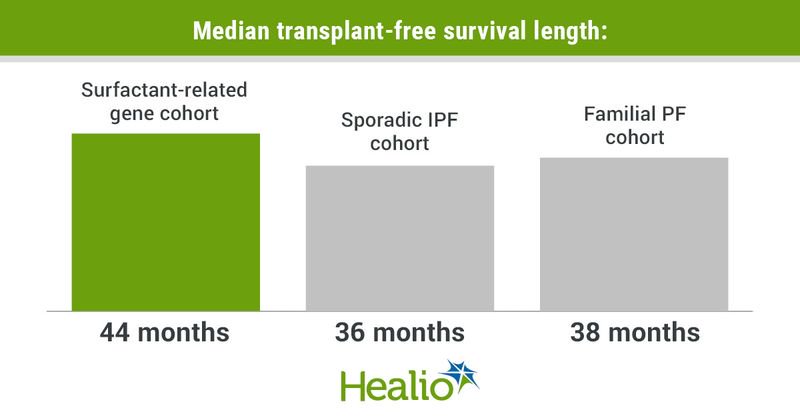Researchers characterize ILD with surfactant-related gene mutations
Key takeaways:
- FVC course was comparable in patients with surfactant-related gene mutations, sporadic idiopathic pulmonary fibrosis or familial pulmonary fibrosis.
- Median survival did not significantly differ between patients.
Patients with interstitial lung disease and surfactant-related gene mutations showed progressive lung function decline and reduced survival that was comparable to that of other ILD groups, according to results published in CHEST.
“This study showed that patients with ILD carrying an [surfactant-related gene (SRG)] mutation experience progressive loss of lung function with severely reduced survival despite possible beneficial effects of treatment,” Dymph Klay, MSc, of the department of pulmonology at St. Antonius Hospital, Nieuwegein, the Netherlands, and colleagues wrote.

In a retrospective observational study, Klay and colleagues analyzed 23 adults (median age, 45 years; 11 men) with ILD and a mutation in an SRG — such as SFTPC, SFTPA2 or ABCA3 — to see how these patients differ from patients with sporadic idiopathic pulmonary fibrosis (sIPF; n = 575) and familial pulmonary fibrosis (FPF; n = 248) in terms of lung function following their diagnosis and while receiving treatment.
Researchers also assessed survival rates among the three groups of patients.
Diagnosis demographics, FVC changes
While more men and older patients had sIPF (82% men; median age, 72 years) and FPF (66% men; median age, 67 years), more women and younger patients made up the SRG mutation cohort.
Assessing lung function at diagnosis, researchers found more reduced FVC in those with an SRG mutation (72.4% predicted) than in those with sIPF (80.2% predicted) or FPF (86.9% predicted). On the other hand, the SRG, sIPF and FPF groups showed similar measures of diffusing capacity of the lungs for carbon monoxide (45.6% predicted vs. 43.7% predicted vs. 50.1% predicted).
Researchers observed no differences in median FVC decline between the three groups of patients, with median declines in the SRG mutation group of 40 mL at 6 months and 117 mL at 12 months.
In linear mixed-model analysis, the use of immunomodulatory or antifibrotic drugs was related to significantly greater reductions in FVC vs. no treatment, according to researchers.
Lastly, median transplant-free survival was comparable between the three disease cohorts, recorded as 44 months in the SRG cohort, 36 months in the sIPF cohort and 38 months in the FPF cohort.
Effect of treatment
Looking further into how 6 months of treatment alters baseline FVC in the SRG cohort (n = 16), researchers found a large range of change (–310 mL to +870 mL), which led them to split the cohort up for more specific analysis.
Although not statistically significant, researchers found positive changes in FVC among the seven patients with a surfactant mutation receiving antifibrotic drugs at 6 months (median, +40 mL; interquartile range [IQR], 40 mL-90 mL) and at 1 year (median, +30 mL; IQR, –270 mL to 60 mL). Nonsignificant improvement in FVC was also observed among the three patients with ABCA3 mutations receiving immunomodulatory drugs at 6 months (median, +610 mL; IQR, 480 mL-740 mL).
Positive lung function changes were not observed among the six patients with a surfactant mutation receiving immunomodulatory drugs, with a 120 mL (IQR, –215 mL to –120 mL) reduction in median FVC at 6 months and a 440 mL (IQR, –510 mL to –370 mL) reduction at 1 year.
When comparing FVC of these subgroups in linear mixed models, researchers found that FVC of those with ABCA3 mutations significantly differed from those with a surfactant mutation receiving immunomodulatory drugs (P < .001). Additionally, FVC of those with a surfactant mutation receiving antifibrotic treatment differed from those receiving immunomodulatory treatment (P = .045).
“Treatment of adults with an SRG mutation may have a favorable effect on slowing lung function decline; however, more research is needed to determine the best and perhaps gene-specific treatment approach for each individual patient,” Klay and colleagues wrote. “Because of late disease detection and the progressive nature of disease in adults with ILD carrying an SRG mutation, screening asymptomatic relatives is recommended.”
Helping this patient population
This study by Klay and colleagues emphasizes the need for studies with a larger sample of patients with an SRG mutation in order to understand progression and treatment, according to an accompanying editorial by Kathryn Friedman Flack, MD, and Jeremy Katzen, MD, of Perelman School of Medicine at University of Pennsylvania.
Notably, survival findings from the study demonstrate the importance of timely transplant referral in patients with this mutation, Flack and Katzen wrote.
“Concerningly, despite being diagnosed with ILD over 2 decades earlier, the survival of subjects in the SRG mutation cohort (44 months) was not significantly different from those with FPF or sporadic IPF,” Flack and Katzen wrote. “Thus, despite the potential for a lead-time bias, given the familial component of disease in this cohort, patients with SRG mutations succumb to their ILD at a significantly earlier age than patients with sporadic disease. This finding should inform consideration for early lung transplantation referral for these patients and speaks to both the need to determine which available pharmacologic treatments are the best option in these patients and to investigate new targeted treatments.”
